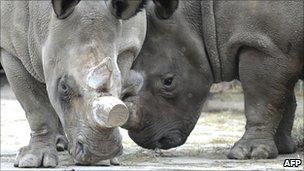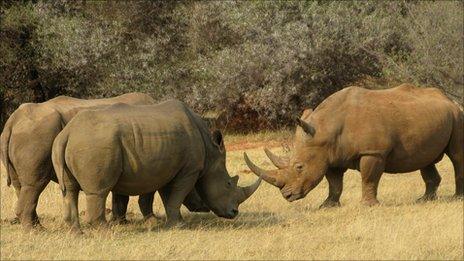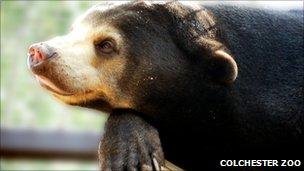Clone zone: Bringing extinct animals back from the dead
- Published
It is like a military operation.
There are team briefings, kit is checked and then checked again.
But dealing with South East Asia's sun bear is not straightforward. It is the world's smallest bear - but also one of the most dangerous.
Today, two are being moved between zoos in the UK - from the Rare Species Conservation Centre in Kent to Colchester Zoo in Essex.

Sun bears are very small, but extremely fierce
But while the bears are anaesthetised and given an essential check-up before their journey, it also gives Dr Masters access to a precious resource: their DNA.
Dr Masters explains: "We are losing species too quickly, therefore we ought to preserve at least the genetic material that has taken millions and millions of years to evolve."
The sun bear samples are heading to the Frozen Ark, which has its headquarters at the University of Nottingham.
Here they are frozen and then stored with samples that have been collected, by a network of vets and scientists, from endangered species all around the world.
The team behind the Frozen Ark says that it could provide the ultimate back-up plan for when all other conservation efforts fail.
Dr Ann Clarke, one of the Frozen Ark's founders, comments: "Like Dolly the sheep, although scientists do not like to talk too much about this, there is a very real possibility that we might be able to one day bring back an extinct or a very endangered species."
While bringing extinct animals back from the dead sounds like science fiction, thanks to recent advances in cloning technology it is much closer to reality than you might think.
In 2009, a Spanish team created a clone of the extinct Pyrenean ibex.
The animal died shortly after birth, but it has marked the beginnings for this new - and controversial - branch of conservation biology.
Professor Robert Millar thinks this technology could prove to be the saviour for the beleaguered rhino.
We join him in a wilderness reserve in South Africa where the current threat to this horned giant is all too apparent.
More than 200 rhinos have been killed by poachers in the last year, their horns sold in Asia and the Middle East where they are used for medicine and ornaments.
The situation has got so bad that locals have likened it to the rhino wars of the 1980s, and we have been asked not to name our location for fear this area could also be targeted.
The southern white rhinos here, at first appearing like boulders on the shimmering horizon of the African bush, were until recently a conservation success story.
This species was brought back from the brink of extinction through tough protection measures.
But all of this hard work could be undone. The renewed threat of poaching has meant the number of deaths is close to, if not already exceeding, the number of births.
Professor Millar, director of the Institute for Breeding Rare and Endangered African Mammals (Ibream) and director of the MRC Human Reproductive Sciences Unit, says it is time to put back-up plans in place.
At the moment, he says, very little is known about the southern white rhino's reproductive biology, so the Ibream team has been looking at hormones in the animal's droppings to find out more.

The northern white rhino is worryingly close to extinction
And with this key information, should the southern white numbers begin to plummet once again, scientists can more easily embark on captive breeding programmes, artificial insemination or even IVF.
But this knowledge could also help an animal in an even more critical state: the northern white rhino.
This close cousin of the southern white is a whisker away from extinction.
There are practically none in the wild and only a few ageing animals left in zoos.
But Professor Millar thinks cloning could prove to be a plan B - thanks to some northern white tissue collected and stored several years ago at the National Zoological Gardens of South Africa.
He says: "Cloning is very extreme but, given the fact that the northern white rhino is on the verge of extinction, I think we need to consider this technology."
Professor Millar explains: "We are using techniques to encourage these cells to become what we call pluripotent, which means they can become any kind of cell.
"And in that way you can turn these cells into embryos."
But if the team can succeed in creating embryos, it needs somewhere for the foetuses to grow. And this is where the southern white could help.
These rhinos are so closely related to the northern white that they would make the perfect surrogate in which to implant the clone.
He says: "With that kind of approach one could hopefully recreate northern white rhinos."

Could cloning safeguard the white rhino?
While the northern white rhino's comeback might be some years off, this work, and the various international efforts to bank endangered animals' DNA, suggests that cloning could form part of a future conservation strategy.
However, it is not without its critics.
Some say that the technical hurdles are just too high: the current low success rate of this technology and the question of where to implant a cloned embryo if no close surrogates are available are just a few of the problems.

Scientists say it is important to collect samples from animals like the sun bear, before it is too late
And then there is the expense: this technology is costly, and it could drain funds away from tried and tested conservation measures.
Add to this the ethics - the argument that this takes meddling with nature several steps too far.
But for the Frozen Ark's Dr Clarke, these objections can all be dealt with later. The important thing for her is to bank genetic material now before it is too late.
She says: "It is for future generations to decide what should be done with the materials available.
"If we at this stage haven't preserved that material, we will have no options. We will have no choice, we will be able to do nothing."
However, she adds that she has not given up hope that many species can still be saved without having to use this controversial technology.
But we need to act now and we need to act quickly.
And if this can be done, she says, this genetic weapon of last resort can be left safely stored for posterity in the freezer. A frozen reminder of the conservation crisis we faced in 2010.
- Published27 October 2010
- Published28 October 2010